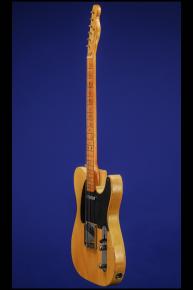A Fine Original '53 Telecaster in it's Original “Thermometer” Case.
1953 Fender Telecaster.
This fifty-nine year-old. lightweight Butterscotch Blond beauty weighs just 6.50 lbs. and has a nut width of just under 1 5/8 inches inches and a scale length of 25 1/2 inches. Solid ash body and a wonderful thick profile fretted maple neck with 21 frets and black dot position markers. Single "round" string tree. Headstock decal with "Fender" spaghetti logo in silver and "Telecaster" in black below it. Individual "no-name" Kluson Deluxe tuners with oval metal buttons and slot-head screws. The tuning keys are stamped "2356766/PAT. APPLD" on the bottom base. One plain metal-cover "black-bottom" pickup with slot-head adjusting screws (at neck) with an output of 5.05k, and one black six-polepiece "copper-coated metal plate bottom" pickup with flush polepieces (angled in bridgeplate) with an output of 7.21k. Single-ply black Bakelite pickguard with five screws. Two controls (one volume, one blender) plus three-way "tone" switch (with slot-head screws) and original "patent number" black plastic "barrel-like" tip, all on metal plate adjoining pickguard. Shorter chrome knobs with more pronounced domes and heavy knurled sides. Telecaster combined bridge/tailpiece with three (flat-ground on bottom) brass saddles and slot-head intonation adjustment screws. Serial number ("1768") on the bridge plate beneath the words "FENDER/PAT. PEND." The neck is dated in pencil "10-53" and the body neck-pocket is dated in red pencil "10-53 / Tad". The control cavity has the original 'tape' inside with "Mary / 10-23-53" written in pencil. The solder joints are covering the stamping on the both of the potentiometers (except for the last two numbers "23", but nothing has ever been touched in this guitar. The three-way switch is stamped "CRL 1452." This guitar is in remarkably fine condition. There are a few small marks and "dings" on the body and some light edge-wear. The neck has been expertly re-fretted with the correct gauge fretwire and there is some wear to the fretboard. The Butterscotch has mellowed to a rich, creamy color. The lovely grain of the ash body shows very well through the Blond finish and this fifty-nine-year-old gem is quite simply one of the best 1953 Telecasters that we have ever seen. Housed in its original Fender, four-latch brown "thermometer" hardshell case with light brown plush lining (8.75).
"Both the Telecaster and the Esquire kept their basic 1951 appointments until the mid-50s. In retrospect, their most striking features -- at least cosmetically speaking -- are a typical yellowed blonde finish (a.k.a. 'butterscotch' finish) and a black pickguard, hence the often cited notion of early 'black guard' Tellies. The combination of the two actually gives a distinct look to the early 50s models, which are otherwise considered by many as the ultimate classic Telecaster guitar because of their tone...Besides its peculiar hue, the original blonde finish nicely showcases the ash body heavy grain pattern that later whiter finishes would subdue...[1954] marks the beginning of a number of changes in the appointments of Telecaster guitars. By Fall, the bakelite black guard was replaced by a single ply white trim and a few months later steel superseded brass for the bridge saddles. FENDER also changed the finishing process of the blonde finish...The typical 'butterscotch' colour gave way to a creamier shade which would soon evolve into a lighter off-white finish. Finally, 1954 is also the year when the serial number was removed from the bridge plate to be stamped on the neck anchor plate...(A.R. Duchossoir, The Fender Telecaster, p. 16).
"Leo Fender's new solidbody was the instrument that we know now as the Fender Telecaster, effectively the world's first commercially successful solidbody electric guitar...The guitar was originally named the Fender Esquire and then the Fender Broadcaster, and it first went into production in 1950. It was a simple, effective instrument. It had a basic, single-cutaway, solid slab of ash for a body, with a screwed-on maple neck. Everything was geared to easy production. It had a slanted pickup mounted into a steel bridge-plate carrying three adjustable bridge-saddles, and the body was finished in a yellowish color known as blond. It was unadorned and like nothing else. It was ahead of its time (Tony Bacon, 50 Years of Fender, p. 10).













